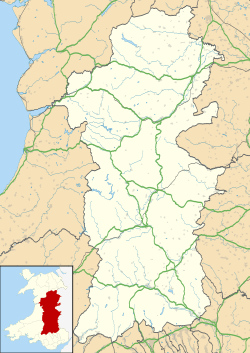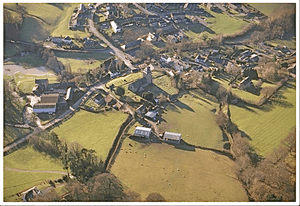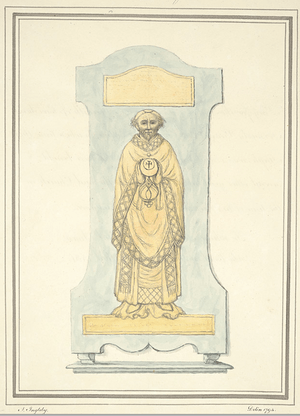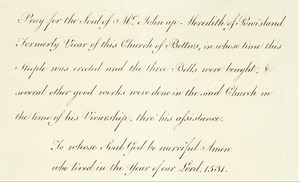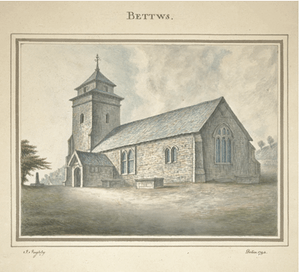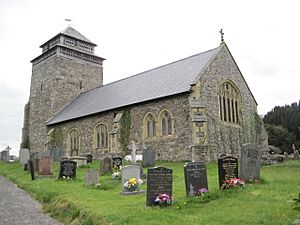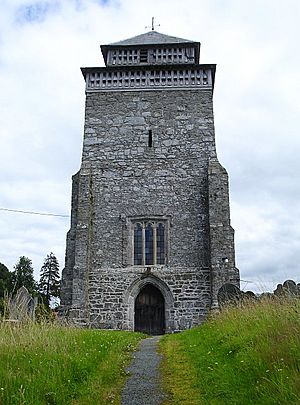St Beuno's Church, Bettws Cedewain facts for kids
Quick facts for kids St Beuno's Church |
|
|---|---|
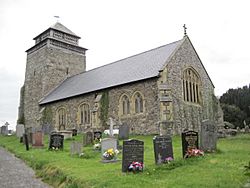
St Beuno's Church, Bettws Cedewain
|
|
| 52°33′37″N 3°17′45″W / 52.560342°N 3.295912°W | |
| Location | Bettws Cedewain, Powys |
| Country | Wales |
| Denomination | Church in Wales |
| History | |
| Founder(s) | St Beuno |
| Dedication | St Beuno |
| Consecrated | Probably 7th century AD |
| Events | Rebuilt 1868 |
| Architecture | |
| Functional status | Active |
| Heritage designation | Grade II* |
| Designated | 21 August 1995 |
| Architect(s) | William Eden Nesfield |
| Architectural type | Church |
| Style | Medieval and Victorian |
| Administration | |
| Parish | Bettws Cedewain |
| Archdeaconry | Montgomery |
| Diocese | St Asaph |
St Beuno's Church is a historic church located in the village of Bettws Cedewain, in Powys, Wales. It sits on a hill, looking over the village and the Bechan Brook valley. The church is about 9 miles southwest of Welshpool.
This church has one main room and a tower on its western side. It is surrounded by a nearly circular churchyard. In the early 1500s, a bell tower, called a campanile or bellcote, was added to the existing tower. This was done by the vicar, John ap Meredyth, and his special memorial plaque is still inside the church today. The church was greatly rebuilt in 1868 by the architect William Eden Nesfield. This included completely rebuilding the top part of the tower.
Contents
Who Was Saint Beuno?
St Beuno was a Celtic saint who lived a very long time ago, dying around 640 AD. We know about his life from old stories. He was born in a place called Banhenic, somewhere in the Severn valley.
Beuno went to study with St Tangusius (also known as Tatheus) in a Roman town called Caerwent. Later, he was given land in Aberhiew (which is now Berriew) by Mawn ap Brochwel. Here, he likely started a large church or a religious community. While in Berriew, he was said to have performed many miracles. He also founded other churches in Powys and North East Wales, including probably the one in Bettws Cedewain. He is most remembered for founding a monastery at Clynnog Fawr in Caernarfonshire.
The Church's Early History
It is believed that St Beuno founded this church around 600 AD. The churchyard is almost oval, which might mean it was a very early church or a monastic settlement from the early Middle Ages.
In old records, the church was called Eccli'a de Bethus in 1254 and Ecclesia de Bethys in 1291. Between 1254 and 1272, it became one of the churches owned by the Cistercian abbey of Strata Marcella. It stayed connected to this abbey until the time of the Dissolution of the Monasteries, which happened in the 1530s.
Thomas Pennant's Visit in 1775
In July 1775, a famous traveler named Thomas Pennant visited Bettws Cedewain. He wrote about the church in his book Tours in Wales. His writings tell us what the church looked like back then.
Pennant noted that the church's steeple (the tall pointed part of the tower) was quite noticeable. He wrote that it was built by one of the church's ministers. He also mentioned seeing a brass plaque with the figure of a priest carved on it, attached to one of the walls. This plaque was for John ap Meredyth, who died in 1531. It was during his time that the steeple, with its three bells, was added to the top of the tower.
Pennant also said that this special brass plaque, which is the only one of its kind in Montgomeryshire, used to be on a large wooden chest. This chest was still in the church when he visited. Pennant later hired an artist named John Ingleby to create watercolors for his book. In 1796, Ingleby drew the church with its campanile, the brass plaque, and even provided a translation of the Latin writing on it. These drawings are now kept at the National Library of Wales.
Church Design and Features
The church's tower is one of the few in Montgomeryshire built in the Perpendicular Period style. However, the tower's history is quite complex. As Pennant mentioned, the wooden steeple was added before 1531. Records show that two of the older bells were remade in 1630. The tower was likely rebuilt in the early 1700s. John Ingleby's watercolor shows it had arched windows, similar to those in nearby Llanllwchaiarn church. The upper part of the tower and the main body of the church were rebuilt in 1868 by William Eden Nesfield.
The only part that truly looks like the Perpendicular style is the three-part window on the west side of the tower. The stone molding above this window suggests it was built very late in that period. The lower parts of the tower are even older. There's an old Romanesque-style door in these lower sections. This might mean the tower was first built in the early 1200s.
The church does not have a separate chancel (the part of the church near the altar). The windows in the church now look similar to those in Ingleby's old drawing. The roof, with its arched beams, has been completely replaced.
The font (where baptisms take place) has seven sides with decorative circles. It was made to look like the old one. There is also a special pulpit from 1859, which was moved here from Hawarden church. Behind the altar, there is a stone carving called a reredos. It has white figures against colorful marble and was given in 1871 to remember J. W. Buckley-Willames.
The stained glass windows are also interesting. The east window, made after 1868 by William Wailes, shows the Ascension. On the south side, there are various decorative pieces. These include a small scene of the Nativity and Crucifixion from the early 1500s. There are also later figures, which are thought to have come from Glastonbury Abbey and other churches in Somerset.
The churchyard also contains the grave of a soldier from the Monmouthshire Regiment who died in World War I. This grave is cared for by the Commonwealth War Graves Commission.
Gallery
See also
Further Reading
- Scourfield R. and Haslam R. (2013), "The Buildings of Wales: Powys; Montgomeryshire, Radnorshire and Breconshire", Yale University Press.
- Thomas, D.R.( 1908) History of the Diocese of Saint Asaph, Vol 1, 128–135.


